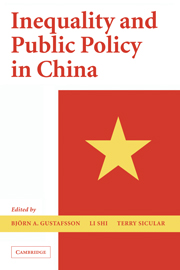Book contents
- Frontmatter
- Contents
- List of Tables and Figures
- Contributors
- Acknowledgments
- 1 Inequality and Public Policy in China: Issues and Trends
- 2 Income Inequality and Spatial Differences in China, 1988, 1995, and 2002
- 3 Growth and Distribution of Household Income in China between 1995 and 2002
- 4 Explaining Incomes and Inequality in China
- 5 The Distribution of Wealth in China
- 6 Growth, Inequality, and Poverty: A Comparative Study of China's Experience in the Periods before and after the Asian Crisis
- 7 What Has Economic Transition Meant for the Well-Being of the Elderly in China?
- 8 Inequity in Financing China's Health Care
- 9 China's Emerging Urban Wage Structure, 1995–2002
- 10 Unemployment, Earlier Retirement, and Changes in the Gender Income Gap in Urban China, 1995–2002
- 11 What Determines Living Arrangements of the Elderly in Urban China?
- 12 The Impact of Village-Specific Factors on Household Income in Rural China
- 13 The Redistributive Impact of Taxation in Rural China, 1995–2002: An Evaluation of Rural Taxation Reform at the Turn of the Century
- Appendix: The 1995 and 2002 Household Surveys: Sampling Methods and Data Description
- Index
- References
9 - China's Emerging Urban Wage Structure, 1995–2002
Published online by Cambridge University Press: 25 July 2009
- Frontmatter
- Contents
- List of Tables and Figures
- Contributors
- Acknowledgments
- 1 Inequality and Public Policy in China: Issues and Trends
- 2 Income Inequality and Spatial Differences in China, 1988, 1995, and 2002
- 3 Growth and Distribution of Household Income in China between 1995 and 2002
- 4 Explaining Incomes and Inequality in China
- 5 The Distribution of Wealth in China
- 6 Growth, Inequality, and Poverty: A Comparative Study of China's Experience in the Periods before and after the Asian Crisis
- 7 What Has Economic Transition Meant for the Well-Being of the Elderly in China?
- 8 Inequity in Financing China's Health Care
- 9 China's Emerging Urban Wage Structure, 1995–2002
- 10 Unemployment, Earlier Retirement, and Changes in the Gender Income Gap in Urban China, 1995–2002
- 11 What Determines Living Arrangements of the Elderly in Urban China?
- 12 The Impact of Village-Specific Factors on Household Income in Rural China
- 13 The Redistributive Impact of Taxation in Rural China, 1995–2002: An Evaluation of Rural Taxation Reform at the Turn of the Century
- Appendix: The 1995 and 2002 Household Surveys: Sampling Methods and Data Description
- Index
- References
Summary
Introduction
Since the mid-1990s the pace of economic reform in China's urban labor market has accelerated. One contributing factor was the draconian labor retrenchment program in the state sector: many previously secure workers were thus thrown into a new labor market. Another contributing factor was the corporatization or privatization of much of the state sector. This institutional change brought with it less state control and more concern with profits. Nevertheless, various obstacles to the creation of a functioning labor market continued. The social and collective nature of the Chinese work unit (danwei) remained powerful, and the rate of labor mobility between employers remained extremely low. In this chapter we examine the ways in which the urban wage structure changed over the 1995–2002 period, and in particular the extent to which wages came to be determined by market forces.
We draw on the two strictly comparable cross-section CHIP surveys relating to the years 1995 and 2002, described in Chapter 1 and the Appendix to this book. Owing to the administrative and economic divide between urban and rural China, reflected also in the organization of survey work by the National Bureau of Statistics (NBS), separate survey instruments were employed in the urban and rural areas. In this chapter we analyze the two urban samples, which covered 11 provinces in 1995 and 12 provinces in 2002 (effectively the same number, as Sichuan and Chongqing had been divided in 1999).
- Type
- Chapter
- Information
- Inequality and Public Policy in China , pp. 221 - 242Publisher: Cambridge University PressPrint publication year: 2008
References
- 20
- Cited by



